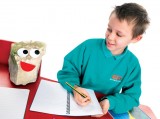If rocks and soils is possibly the most boring topic you’ve ever taught, Jonathan Lear has an idea that will turn it into a pupil favourite
As many schools work towards redesigning their curriculum, there has been a shift from the prescribed nature of QCA schemes to increasingly personalised units of work. However, what we can’t move away from, at least for the moment, are the statutory requirements of the National Curriculum.
In the KS2 science curriculum, under ‘Materials and their properties’, lurks the following gem:
Children must learn to describe and group rocks and soils on the basis of their characteristics, including appearance, texture and permeability.
Without wanting to offend budding geologists, this statement makes my blood run cold. As an adult, I can’t think of anything that I’d less like to learn about. Despite its apparent joylessness, it’s still there, just waiting for our expectant eight-year-olds.
As I see it, there are two options: we can either ignore it and hope it goes away, or attempt to transform it into something immeasurably more exciting.
If you’re interested in option two, then you might want to try this…
In terms of the curriculum, the learning that’s required is as follows. Children will:
• name and give characteristics of several rocks;
• explain that rocks are used for different purposes;
• recognise that there is rock under all surfaces and that soils come from rocks;
• recognise when a test or comparison is unfair, and say what their experiments and investigations show.
For this to be of any value, it needs to be enjoyable; something that requires both creative teaching and creative learning. With this in mind, personification can be an incredibly powerful tool. The idea of bringing inanimate objects to life in order to discover a little more about them is useful in lots of different contexts, none more so than with rocks.
Before we start, there are some resources that need to be gathered. As part of the rock collection, there needs to be both permeable (chalk, sandstone) and non-permeable rocks (granite, marble). Any additional igneous and sedimentary rocks can also be included.
If you’ve previously taught this topic, then it’s likely that you already have most of what you need at hand. Ideally, the more rocks you have the better as it gives the children more opportunity to be involved.
 Before you begin, the rocks in question need to be brought to life. For now, this is achieved by applying eyes to each of them. The wobbly ones that you can get from craft shops work really well, and a glue gun or something equally sticky usually does the job. With eyes in place, you will have before you a collection of similar looking rock creatures that are ready for action.
Before you begin, the rocks in question need to be brought to life. For now, this is achieved by applying eyes to each of them. The wobbly ones that you can get from craft shops work really well, and a glue gun or something equally sticky usually does the job. With eyes in place, you will have before you a collection of similar looking rock creatures that are ready for action.
There may be scientifically minded people out there who find it disagreeable to stick googly eyes or false teeth onto a rock. In my opinion, regardless of what the rocks are turned into, they’re still rocks and therefore have the same properties. The children will learn the same key facts as before; they’ll just care more about what they’re doing.
 With the rocks prepared, they will need to be hidden around the school grounds or building just before you intend to start the first session with the children.
With the rocks prepared, they will need to be hidden around the school grounds or building just before you intend to start the first session with the children.
With everything in place and the children ready, tell them a background story about how the rocks came to be at the school. You could cautiously show them a rock character; (reminding the children that the rock is very shy and has to be looked after!) then tell them that whilst your rock is now safe, there are many more that need rescuing from around school. In pairs, or small groups, their job is to rescue the rocks and bring them back to the safety of the classroom.
When all the rocks are collected, bring the children back together. Remind them they are now the owners of these strange rock creatures and will have to look after them as if they were their new best friends.
The first task they face is to find out a little bit more about the rocks. These initial observations could be focused on specific questions you wanted the children to answer. Equally, it could be led by the children themselves who are given the opportunity to generate their own questions and ideas. The recording of this can be done in many different ways; children could draw, sketch, write, photograph, or film their observations to be fed back to the rest of the class. Following this, the children could either group themselves with others that had observed similar things, or with those who had contrasting observations.
With your classroom now taken over by the rock creatures, there are further avenues to explore.
To develop the children’s understanding of their observations, the ideas that they’ve shared can be questioned – you’ve said it’s hard, but how do you know? Can you prove it? If the children were given a range of equipment, could they design experiments that would test their theories? This could be directed by the children with the teacher giving support by sharing some golden rules about investigations or providing a framework in which to work.
To take the identification of properties further, the rock characters themselves could be developed.
Having identified some of their properties, the children could personalise their creatures by adding to their appearance and naming them. They could then create Top Trumps style cards based on common features. Categories would have a numerical rating, e.g. hardness ‘9’, Permeability ‘3’. The children would decide on rules for the game and they could play against each other.
Again based on properties, this activity asks children to put together their own rock band. They would have to look for members that brought different qualities to the band – the hard lead singer (granite) would take its place alongside the more sensitive member of the band (chalk). The children could make profiles for a rock band annual or website:
Name: Gary Granite
Hardness: Very
Permeability: I ain’t no sponge!
Hopes for the future: To be Cheryl Cole’s kitchen worktop
Budding designers might want to develop some rock creature fashions. Given what the children know about the properties of their rocks, what kind of clothing would be appropriate? (There’s no right or wrong answer for this, as long as they can justify their decisions and back them up with scientific evidence.) For example, they might decide that Gary Granite needs a padded jacket because he’s not only cold to the touch, but also at risk of damaging other rock creatures due to his hardness. Chalk on the other hand would need some sort of waterproof hat to combat his permeability.
Allowing the children to express their learning in various different ways gives a greater sense of independence and ownership. They may go for one of the above ideas, but they might also have their own. Throughout it all, they are arriving at the same learning, using the same vocabulary and experiencing what makes a successful investigation. The only problem you’re likely to have is the children becoming too attached to their new found friends. So if you’ve always hankered after a class pet but are unsure about the smell, rock creatures could be the low-maintenance solution you’ve been waiting for.
Should you let educational researchers into your classroom?
Ace-Classroom-Support
